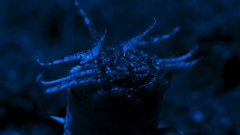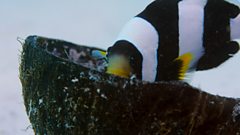Coral Reefs
The wildlife documentary series narrated by David Attenborough reveals the ingenious ways life exists in the undersea cities of tropical reefs.
Corals build themselves homes of limestone in the warm, clear, shallow seas of the tropics. Their reefs occupy less than one tenth of one per cent of the ocean floor, yet they are home to a quarter of all known marine species. They are complex, infinitely varied structures providing all kinds of homes for their many residents. There is fierce rivalry for space, for food and for a partner, but the reef is also a place full of opportunity. For those that manage to establish themselves, there can be great rewards.
The broadclub cuttlefish has found its place by using a hypnotic display that apparently mesmerises its prey, causing it to let down its defences. On the Great Barrier Reef a remarkable grouper uses sign language, dubbed the headstand signal, to reach out to an entirely different creature, a reef octopus, to flush small fish out of their hiding holes and into the groupers waiting mouth.
While they might appear to be nothing more than rocky substrate, each coral is in fact made up of hundreds to thousands of tiny, living coral creatures called polyps. Filmed with super macro time-lapse, we bring them to life and reveal their hidden worlds. As these polyps grow and die they lay the limestone foundation for civilisations and superstructures so large that they can be seen from space.
Coral reef cities never sleep, they are constantly noisy worlds where a chorus of submarine song rings out from their many inhabitants. At dawn, one of the reef's most charismatic inhabitants, the green turtle, heads off to be cleaned at a special health spa. As she approaches the station, she is joined by more of her fellow turtles and is pushed out by the queue-jumping males. She must wait for her opportunity to sneak back in.
Some animals come to reefs for rest and relaxation. In the desert sands of Egypt, coral reefs thrive in the shallows of the Red Sea, providing bottlenose dolphins with a place to rest. For the youngsters, the reef is their playground. These dolphins play by balancing corals and sponges on their nose and in doing so build important life skills.
Every reef has a sharply defined boundary. On the outer side, facing the open ocean, is the drop-off. These ramparts protect the city from the ocean waves, but twice a day the walls are covered by the incoming tide. In the Bahamas, the rush of the water creates a truly strange phenomenon - a whirlpool. In the Maldives, on the biggest tides, one particular coral lagoon becomes so flooded with plankton that it attracts hundreds of manta rays.
On the sheltered side of the reef there are sand flats which provide rich feeding grounds. However, away from the protective structures of the reef there is nowhere to hide. This makes it a dangerous place, especially at night when predators patrol in search of prey caught in the open. The bobbit, a giant carnivorous worm, buries deep in the sand in order to ambush unsuspecting prey. But there is safe accommodation for some out here in these sandy suburbs. An extraordinary species of clownfish has made a home in an anemone away from the reef. But it is up to the big male to find a way for the female to lay her eggs.
Reef creatures go to great lengths to give their young a head start in life and nowhere more so than on the remotest reefs in the world. In French Polynesia, thousands of grouper risk death when faced with hundreds of grey reef sharks in order to reproduce.
Despite their longevity and resilience, increasing ocean temperatures have put coral reefs under unprecedented pressure. The most devastating bleaching event known in recorded history wreaks havoc on the Great Barrier Reef in Australia. Without the three-dimensional structure of a coral reef, all reef dwellers are affected. The programme unfolds with one of the greatest mass-spawning events in the oceans - corals, fish and invertebrates all releasing a snowstorm of eggs. By sending their young away from the reef, there is hope that they will regenerate new reefs and secure their future for generations to come.
Last on
More episodes
Previous
Next
Clips
-
![]()
Beware the Bobbit worm
Duration: 01:40
-
![]()
Cooperative clownfish
Duration: 01:59
-
![]()
The hypnotising cuttlefish
Duration: 02:08
Music Played
-
![]()
Hans Zimmer, Jacob Shea & David Fleming
Walrus: The Right Piece of Ice
-
![]()
Hans Zimmer, Jacob Shea & David Fleming
Surfing Dolphins
Credits
| Role | Contributor |
|---|---|
| Narrator | David Attenborough |
| Executive Producer | James Honeyborne |
| Series Producer | Mark Brownlow |
| Producer | Jonathan Smith |
| Production Manager | Katie Hall |
Broadcasts
- Sun 12 Nov 2017 20:00
- Sun 19 Nov 2017 15:35Βι¶ΉΤΌΕΔ One Northern Ireland HD & Northern Ireland only
- Sun 19 Nov 2017 15:50Βι¶ΉΤΌΕΔ One Scotland HD, Wales HD, Scotland & Wales only
- Sun 19 Nov 2017 16:50Βι¶ΉΤΌΕΔ One except Northern Ireland, Northern Ireland HD, Scotland, Scotland HD, Wales & 1 more
- Tue 28 Nov 2017 01:10
- Mon 5 Nov 2018 15:45Βι¶ΉΤΌΕΔ Two except Scotland
- Tue 16 Apr 2019 20:00
- Wed 17 Apr 2019 02:00
- Sun 19 Jan 2020 16:40Βι¶ΉΤΌΕΔ One except Scotland, Scotland HD, Wales & Wales HD
- Sun 29 Nov 2020 16:50Βι¶ΉΤΌΕΔ One except Wales & Wales HD
- Wed 7 Jun 2023 13:30Βι¶ΉΤΌΕΔ One except Channel Islands, East Midlands, HD, London, Northern Ireland & 8 more
- Sun 8 Oct 2023 16:45
- New Year's Day 2024 16:45Βι¶ΉΤΌΕΔ One Wales & Wales HD only
- Thu 4 Jan 2024 19:00
- Fri 5 Jan 2024 01:30
- Sun 18 Feb 2024 10:30
- Sun 18 Feb 2024 17:05Βι¶ΉΤΌΕΔ Two Wales & Wales HD only
- Sun 30 Jun 2024 10:30
- Thu 12 Sep 2024 19:00
- Tue 22 Oct 2024 17:05Βι¶ΉΤΌΕΔ Two Wales & Wales HD only
Download an Oceans poster and discover more about life in the oceans
Visit OpenLearn, the OU’s home of free learning, to learn more about the oceans
Get involved with ocean conservation
Get ideas on how you can help sea life.
Dive deeper to see how Blue Planet II was made
Read articles and watch clips showing how we created the series
Download the podcast
Join us for a deeper look into each episode of Blue Planet II






